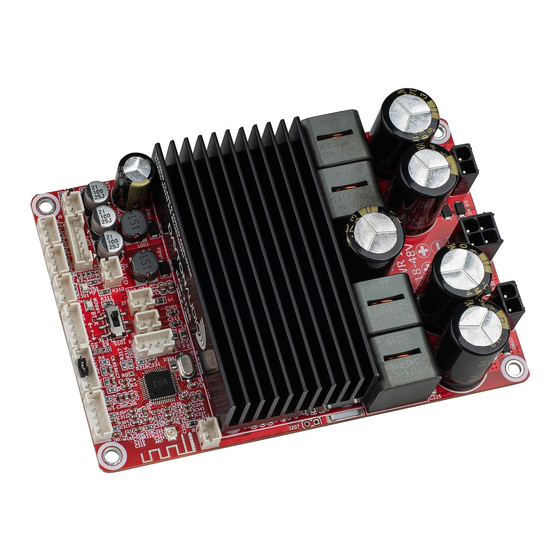DaytonAudio KAB-2150 Manuale d'uso - Pagina 16
Sfoglia online o scarica il pdf Manuale d'uso per Amplificatore DaytonAudio KAB-2150. DaytonAudio KAB-2150 17. 2 x 150w class d bluetooth 5.0 amplifier board with tone and volume controls

The audio quality or power from my device is not what I expect
1. Check the audio source's audio settings. For example, there might be EQ enabled on your phone
or other Bluetooth source device that is unintentionally altering the sound of your speaker
project.
2. Make sure that your speaker is attached to the amplifier according to this guide or the labels on
the back of the speaker. If your polarity is out of phase (this means the + and – or red and black
labels of the amplifier do not match the corresponding inputs on each speaker), your audio
quality will not be good. Out of phase speakers will lack bass, and the sound will change a lot as
you move around the speakers.
3. If using an auxiliary audio input, note that different audio sources will output different voltages.
Some voltage sources can be quite low, such as budget oriented TVs, laptops, etc. This will affect
the overall output power of your amplifier. If you are getting the volume you expect when using
Bluetooth, but not when using aux input, consider adding a preamp to your aux input source.
4. If you are using a power supply at the lower end of the voltage range an amplifier can use (such
as if you are using a 12V supply for an amplifier that is 12-24V compatible), you might not be
getting as much power out of the amplifier that you need and the amplifier is distorting.
Consider a higher voltage adapter. Similarly, make sure that your power supply can provide the
amperage that the amplifier can pull. If your amplifier requires a max of 24V 3A, but your power
supply is 24V 1A, the audio quality of your amp might suffer.
5. Make sure that your speaker is free of damage and that the connection to the speaker is good
without any cold solder joints or anything that would cause the connection from the amp to the
speaker to be intermittent.
6. If you are using parallel and or series wiring for attaching multiple speakers to the same output,
make sure that you have wired everything to the right impedance. For example, if you accidently
wire two 8 ohm speakers in series, you will get a 16 ohm load that the amplifier cannot drive
well. If you wire two 8 ohm speakers in parallel, you will get a 4ohm load that the amplifier can
drive well. If you wire two 4 ohm speakers in parallel, you will get a 2ohm load that is not in the
working range of the amplifier.
7. Know that if testing the amplifier with a loose speaker driver, the driver (in most cases) will not
produce much bass until it is built into a cabinet or box.
8. Check your enclosure design for air leaks or rattles. If there are binding posts for speaker wire,
make sure that they are tightly secured and not loose where they can rattle.
9. If other devices are being powered with the same power line as your amplifier, such as a
microcontroller, display, etc, try removing these devices temporarily as they might be inducing
noise into your amplifier. If this solves the problem, isolate the amplifier's power supply from
the other device using something like an isolated DC to DC converter or a different power
distribution system.
My Volume and Tone Controls do not work!
1. The KAB-2150 must be in Bluetooth Module mode for these controls to work. If using Bluetooth
bypass mode, these controls will not work. Check the position of the input mode switch. If you
are in the wrong mode, Bluetooth input will not work either.
2. Check that your wiring harnesses are making good connection to your potentiometer assembly.
16
